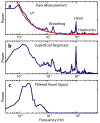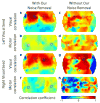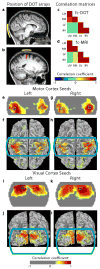Resting-state functional connectivity in the human brain revealed with diffuse optical tomography
- PMID: 19344773
- PMCID: PMC2699418
- DOI: 10.1016/j.neuroimage.2009.03.058
Resting-state functional connectivity in the human brain revealed with diffuse optical tomography
Abstract
Mapping resting-state networks allows insight into the brain's functional architecture and physiology and has rapidly become important in contemporary neuroscience research. Diffuse optical tomography (DOT) is an emerging functional neuroimaging technique with the advantages, relative to functional magnetic resonance imaging (fMRI), of portability and the ability to simultaneously measure both oxy- and deoxyhemoglobin. Previous optical studies have evaluated the temporal features of spontaneous resting brain signals. Herein, we develop techniques for spatially mapping functional connectivity with DOT (fc-DOT). Simultaneous imaging over the motor and visual cortices yielded robust correlation maps reproducing the expected functional neural architecture. The localization of the maps was confirmed with task-response studies and with subject-matched fc-MRI. These fc-DOT methods provide a task-less approach to mapping brain function in populations that were previously difficult to research. Our advances may permit new studies of early childhood development and of unconscious patients. In addition, the comprehensive hemoglobin contrasts of fc-DOT enable innovative studies of the biophysical origin of the functional connectivity signal.
Figures









References
-
- Biswal B, Yetkin FZ, et al. Functional Connectivity in the Motor Cortex of Resting Human Brain Using Echo-Planar MRI. Magn Reson Med. 1995;34:537–541. - PubMed
-
- Bluestone AY, Abdoulaev G, et al. Three-dimensional optical tomography of hemodynamics in the human head. Opt Express. 2001;9:272–286. - PubMed
-
- Boden S, Obrig H, et al. The oxygenation response to functional stimulation: Is there a physiological meaning to the lag between parameters? Neuroimage. 2007;36:100–107. - PubMed
Publication types
MeSH terms
Substances
Grants and funding
- P50 NS006833/NS/NINDS NIH HHS/United States
- F30 NS062489/NS/NINDS NIH HHS/United States
- P50-NS06833/NS/NINDS NIH HHS/United States
- T90-DA022871/DA/NIDA NIH HHS/United States
- R21-EB007924/EB/NIBIB NIH HHS/United States
- K02 NS053425/NS/NINDS NIH HHS/United States
- R21-HD057512/HD/NICHD NIH HHS/United States
- T90 DA022871/DA/NIDA NIH HHS/United States
- R01-NS46424/NS/NINDS NIH HHS/United States
- R01 NS046424/NS/NINDS NIH HHS/United States
- K02-NS053425/NS/NINDS NIH HHS/United States
- R21 HD057512/HD/NICHD NIH HHS/United States
- 1F30NS062489/NS/NINDS NIH HHS/United States
- R21 EB007924/EB/NIBIB NIH HHS/United States
- R01 EB009233/EB/NIBIB NIH HHS/United States
LinkOut - more resources
Full Text Sources
Other Literature Sources

